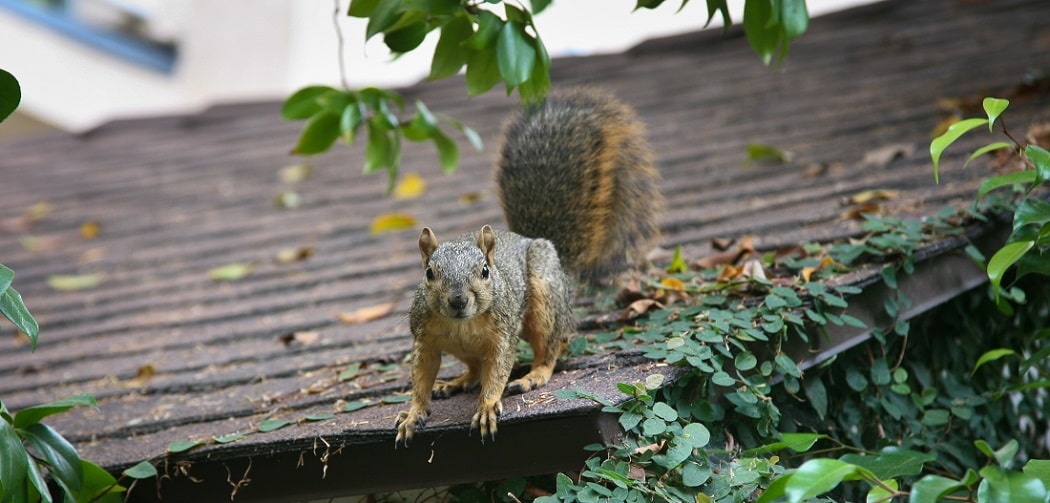
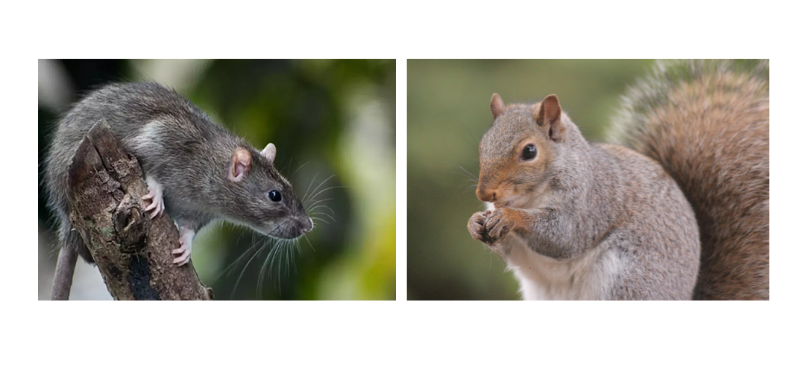
How to Tell the Difference Between Squirrels and Rats
Need Help with Squirrel or Rat Infestation?
Find a Critter Control near you.
When attempting to identify wildlife in the home, homeowners often mistake squirrels and rats. Understanding the similarities and differences between squirrels and rats is key to identifying the type of infestation you have and how to solve it.
Squirrels and rats have several similarities stemming from their belonging to the order Rodentia, which includes other rodent species such as muskrats and beavers. The name “Rodent” comes from Latin and means “to gnaw”. Squirrels and rats, like other rodents, must constantly gnaw on hard materials to keep their incisors ground down and sharpened. Throughout their lifetime, their incisors continually grow. Other similarities include body and head shape, and diet.
Here is how you can tell the difference:
- Appearance: On average, squirrels are larger than rats. Squirrels have thick, bushy tails, whereas rat tails are thin and hairless.
- Nesting Habits: Both species can live indoors, but squirrels are more likely to build their nests in trees. Rats also nest outdoors, but they prefer to raise their young in wall voids or basements.
- Diet: Squirrels forage for nuts, seeds, and flowers. Rats will eat everything from pantry goods to garbage.
- Activity: Squirrels are diurnal. Rats are nocturnal.
- Tracks: Rats drag their tail. Squirrels bound.
Squirrel Poop vs. Rat Poop
Actually seeing a rat or a squirrel inside your attic or interior is rare. Both rodents are skitterish and avoid people. Animal droppings are one of the most obvious signs of a pest problem. However, squirrel droppings and rat droppings do resemble each other.
Homeowners can use feces to tell the difference between a squirrel and a rat infestation. While both types of droppings can be dark brown to black with blunted ends, they are found in different places around the home.
People often find squirrel feces in attics or around tree trunks. In comparison, Rat droppings often appear along baseboards, in cupboards, and behind refrigerators or washing machines.
Rat poop is typically concentrated in one area, as they tend to designate a specific area for a bathroom. Refrain from getting close to squirrel poop or rat feces, as they are known vectors o several diseases.
Nesting Habits
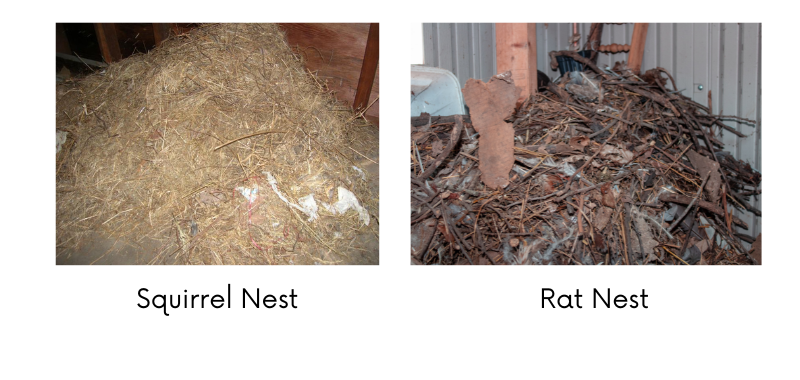
Both rats and squirrels will enter homes, but squirrels are more likely to build their nests outdoors in trees or in the ground. Occasionally, squirrels will build nests in an attic or within gaps of the roof if the area is suitable. Rats also nest outdoors, but they prefer to raise young in wall voids or basements, especially areas close to food sources or warmth.
The nest of a squirrel is typically much larger, composed of clumped-together collections of leaves, twigs, bark, and moss. Rats will use anything available for nest material, including cloth, insulation, cardboard, and plant material. Rat nests are well-hidden, often in walls, crawlspaces, or in insulation.
Squirrel Damage vs. Rat Damage
Squirrels do most of their structural damage outside. While capable of causing significant damage to home and business interiors, squirrels are more likely to dig holes in yards, strip bark from trees, and steal from gardens. As for structures, they tend to chew through roof shingles, house siding, and more to create entry points. Squirrels also are capable of spreading disease to people and pets, including serious illnesses like Lyme disease
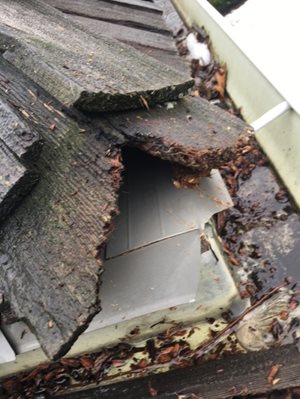
In contrast, rats do most of their damage inside. Rat waste can contaminate pantries, ruin personal property, and carry diseases, including rat-bite fever, plague, and food poisoning.
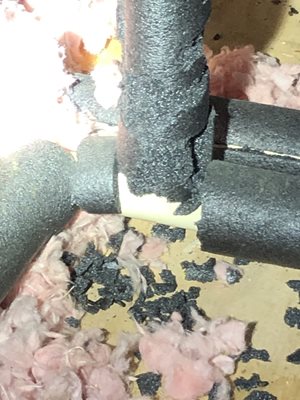
One commonality between rats and squirrels is chewing or gnawing on anything and everything in your house, including electric wires, PVC pipes, and wood. This often occurs in the attic and commonly leads to leaks, power and WiFi outage, and structural damage. Other signs aside from chewing are often needed for the untrained eye to differentiate between a squirrel and rat in your attic.
Squirrel Tracks vs RatTracks
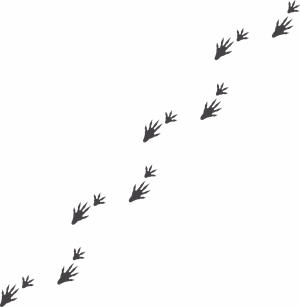
Squirrels bound, leaving behind irregular gaps between paw prints. Additionally, their back toes are longer and come up alongside their front paws as they bound.
In contrast, the tail of a rat drags as it moves, leaving behind an obvious tale mark as they move. In addition to their footprints, they tend to stick to one path. With poor eyesight, they run alongside walls for guidance. As they have oily fur, you may notice smudges or smears along walls and corners.
Activity and Movement
A key difference between a squirrel vs. a rat is the period of activity. Rats are nocturnal critters, meaning they are most active at night. Pay attention to the clock when you hear noises and make a note of the time. This will often provide all the information you need to know. Scuffling behind the wall at 2 am? Most likely a rat or mouse. Thus in the attic? Likely a flying squirrel (or raccoon). However, sounds seem amplified in the middle of the night, so those thuds could come from a rat.
Ground and tree squirrels are diurnal. They forage in the morning until the early evening and return to their squirrel nests at night. Homeowners typically hear noises in the early morning or evening when the critter is leaving and entering the home.
While animals typically stick to their natural behavior, rats are notorious for adapting to the schedule of the inhabitants of the home they have invaded. Thus, they become when everybody is out of the house, day or night.
Diet of Squirrels vs Rats
Squirrels forage for nuts, acorns, seeds, flowers, fruits, and sometimes eggs, insects, and caterpillars. Rats are similar to squirrels in that they are omnivorous and have a varied diet. However, Norway rats prefer a diet with plenty of proteins and carbohydrates and will raid household garbage cans or kitchen pantries for meat, fish, cereal grains, and fresh fruits.
Appearance: Squirrel vs Rat
With a decent visual of the critter, identification is fairly easy. But actually seeing one of these rodents is a unlikely occurance.
Both Fox and Eastern Grey squirrels are on average larger than rats. All squirrel species have thick, bushy tails, whereas rat tails are scaly, thin, and hairless.
The bodies of rats are long and tube-shaped, and their snouts are blunt. Rats also have relatively small, hairless ears and their fur can be brown, gray, black, or even white.
Lastly, rats possess hairless hands and feet. On the other hand, squirrels have larger ears, brown and grey fur color, hair on their feet, and relatively bigger eyes.
How to Get Rid of Rodents
Squirrels and rats both pose serious threats to homes, businesses and the people and pets within. You should never attempt to remove either species without professional guidance. Rats and squirrels require separate solutions, and any infestations should be approached with the most advanced removal techniques. Contact our technicians at Critter Control if you believe you have a rat or squirrel infestation.
Get them out.
Keep them out.®
Experiencing a wildlife or pest issue? We can help! Complete this form and your local Critter Control® office will contact you to assist.
- How to Get Rid of Squirrels
- Squirrels Entering Homes
- Squirrels in Attics
- Squirrels in Chimneys
- Squirrels on Roofs & in Soffits
- Squirrels in Walls
- Squirrels in Ventilation
- Squirrels in Gutters
- Squirrels in Crawl Spaces
- Squirrels in Yards or Gardens
- Squirrels in Trees
- Squirrels Digging Holes in the Ground
- How to Identify Squirrel Sounds
- Squirrel Tracks
- Squirrel Droppings
- Squirrel Trapping
- Squirrel Repellents & Deterrents
- Squirrel Appearance & Identification
- Species & Types of Squirrels
- Squirrel Life Cycle
- Baby Squirrels
- Squirrel Nest
- Dead Squirrels
- Squirrel Diet
- Diseases That Squirrels Carry
- Rabid Squirrels
- Do Squirrels Hibernate?
- Gray Squirrels
- Do Squirrels Bite?
- Squirrel Damage to Your House
- Squirrels vs. Chipmunks